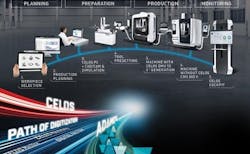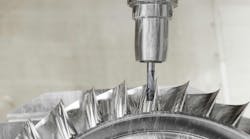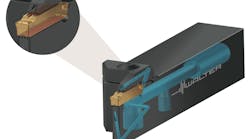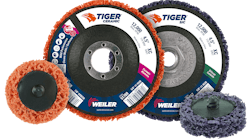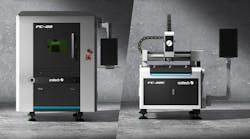IMTS: DMG MORI Presents Automation Solutions
DMG MORI will present itself as the leading competence partner for metal cutting production and digitization on around 17,000 ft2 in Booth 338900 at IMTS 2018 in Chicago, Illinois. Taking “Integrated Digitization” as its guiding principal, the company points the way to the future of the “Digital Factory” with numerous software and data-based products and services.
Integrated Digitization – the digital products of the CELOS Ecosystem enable consistent, customized end-to-end solutions
DMG MORI has further developed its CELOS control and user interface to create an open and consistent ecosystem for digital production. In the current CELOS version, the focus is on digital workflows for adaptive production planning and integrated tool management. DMG MORI’s current digitization initiatives are based on the vision of the digital factory, which is characterized by adaptive factory structures. The digital factory’s key feature is the automatic, data-based adaptation of processes in production to changing framework conditions.
The major focus of the CELOS Ecosystem is its “Open Connectivity” which enables CELOS network integration with machines from other manufacturers, machines in complementary technological areas and manual workstations. Even older machines have to be connected to a certain degree. “This means that, soon, almost any machine and any workstation can be upgraded to become a member of the CELOS network, and this in turn opens up completely new levels of freedom to our customers with regard to optimizing their digital workflows,” promises Dr. Holger Rudzio, the Managing Director of DMG MORI Software Solutions GmbH.
Automation – from a single source – heading towards future-oriented production with standardized and individual automation solutions
Another focus of the development work is automation. It is the aim of DMG MORI that every machine in the wide and varied portfolio can be equipped with an automation option in future. Intelligent linking of the machine tool and automation is a key focus at the production locations in order to ensure customers can receive their automation solution from a single source.
At IMTS, the machine tool manufacturer will be presenting the proven PH 150 pallet handling system, LPP multi-layer pallet pool system, 21 RPP space-saving automation solution, as well as the newly developed, flexible GX gantry loader in the new VERTICO design. Robo2Go 2nd Generation extends the portfolio as a mobile robotic automation system for a large number of turning machines. Integrated turnkey offers that link any number of machines and process-supporting work steps complete the automation range from DMG MORI.
With its Robo2Go 2nd Generation, DMG MORI also has a workpiece handling solution in its range which can be put to flexible use on a number of universal turning machines and which cuts an impressive figure as it is easy to program with CELOS. This year, the CTX beta 800 will demonstrate its easy teach-in functions for different work pieces and flexible setup at multiple turning machines.
DMG MORI also creates larger manufacturing cells comprising of several machines using linear pallet pools (LPPs) and robotic automation systems. The LPP feature provides the most flexible, multi-layer pallet pool systems with up to 8 machines, 99 pallet and 5 setup stations. The NHX 6300 2nd generation automation solution demonstrates the handling of up to 3 different sizes of pallets possible in one system.
“Automated machine tools as a part of future-oriented production guarantee users a high degree of competitiveness,” affirms Alfred Geißler, the Managing Director of DECKEL MAHO Pfronten GmbH. He then goes on to explain that this is precisely why DMG MORI has helped its customers to create the best possible automation solution for every application. “This applies to almost all manufacturing companies nowadays – from small contract suppliers to global players.” After all, he adds, every market participant is competing in a global environment.
The reasons for automation are as diverse as the possible automation solutions. Cost effectiveness, flexibility and reliability are just three examples of the possible benefits. “Only an automation solution has a higher level of repeat accuracy than any manual workpiece clamping and unclamping operation,” Harry Junger, Managing Director of GILDEMEISTER Drehmaschinen GmbH, explains providing an example.
